Each gardener landed on its plot predominantly long-acquired plants, rarely deciding to experiments with exotic cultures. However, there are decorative shrubs that are in service with almost every amateur gardening and design. One of these crops is a host - the real queen of the shade, which perfectly decorate the most shady corners of the garden and the plot.
Host Christmas Three refers to the most popular varieties of a given decorative plant, which is distinguished by excellent survival, unpretentiousness, endurance to the cold and shadow. It can be used as a background for many other cultures, as well as as a soil plant. Host Christmas Three, landing and care for which is practically no different from other varieties, will like each gardener and will become an excellent addition to the collection of decorative cultures.
To decorate your site of the Emerald Hosts, in this article, consider the description and features of this plant, we give the most basic use options in the landscape. And also note the important rules for landing and care for the host of Christmas three.
Features and Botanical Description of the Hosts of Christmas Three
Host or Funkiya Christmas Three is a representative of the kind of perennial herbaceous plants, which belong to the Sparezhye family. However, quite recently, this plant has many scientists attributed to the Lily Family. The name of this kind was given in honor of the Austrian Botany and N. Host, who was actively studying this plant. Another scientific name of the culture "Fuankia" was also given a host in honor of the scientist - German botany. The varietal name of the long-term plant of the host Christmas three received in honor of the Christmas tree for a beautiful green foliage with a gentle yellow-salad border.
Host Christmas Three was derived in 1982 by scientists by K.Vaughn and M.Seaver breeders who demonstrated this magnificent and one of the most powerful hosts. The natural area of \u200b\u200bhabitat of this culture is the territory of Japan, China, Sakhalin, Kuril and the Far East, although different varieties are found in almost all corners of the planet. In the wild environment, the moisture-in-law of the host prefers to shave off the banks of the rivers and lakes, on the slopes of the mountains and on forest edges. On the territory of Europe, the host appeared in the 19th century and at that time was considered one of the rarest plants, which was manifested in some botanical gardens. Gradually, the host began to gain popularity and appeared in many gardens.
One of the most popular varieties of Host Christmas three almost from the very beginning has gained popularity among the gardeners around the world. This plant has become an integral part of many garden compositions and landscape design, it can decorate even the most shaded and dark corner of the garden.
DESCRIPTION OF HOSTA CRISTMAS Three:
- Host Christmas Three is a decorative-deciduous perennial, a herbaceous plant that has a high decorative value.
- This variety has a very powerful rhizome, which can be perfectly maintained even in the most severe frosts. This allows the host every year to produce new large leaves.
- Host Host Hybrid Christmas is considered the largest representative of this kind. The height of the shrub reaches an average of 50-60 cm, while the floweros length varies from 35 cm to 45 cm. Such bushes are distinguished by the large diameter of the leaves, which is approximately 70-90 cm.
- It has moderate growth.
- The main decoration of the host of this variety is bright and beautiful leaves, which per season achieve just huge sizes.
- Sheet plate is oblong, in the form of a heart-shaped. Surface with small grooves, waffle and dense. The top of the sheet matte, and the bottom has a peppy flare. Adult leaves are strongly compressed, have a wavy edge.
- The leaves are mainly a dark green shade with a spectacular cereal creamy yellow edge.
- In length, the leaves can be maximally reach 25-30 cm, and wide up to 25 cm.
- The sheet plate is attached to the pet, which grows directly from the rhizoma of the plant, so all the leaves together create a root rosette of a beautiful cascade, pyramidal and rounded shape.
- During the season, the chosts of the Christmas leaves three strongly grow and create extensive curtains.
- Flowers of this plant look very unusually, which can also be considered a bright decoration of the site. However, many gardeners cut off all the flowers with not yet blossomed flowers, thereby giving the plant to direct all the forces on strengthening and dissolving new leaves.
- Flowerines appear from the corps of the host and completely devoid of foliage. In length, they can reach about 35-45 cm.
- Flowers Hosts Christmas Three Triple-shaped Forms. They are very small and painted in a pale lavender shade. Collected in small private inflorescences.
- The host of this variety begins its flowering around mid-July and lasts until the end of the summer.
- After flowing, the flowers on the flowers begin to ripen fruit - seed boxes of small size with a slightly lean surface. Boxes have a light brown shade. Inside them are small seeds, the length of which is approximately 2-3 mm.
- Culture has very good stability to cold and frost. Refers to the climatic zone 3, which corresponds to -40 / -34 degrees of frost. Therefore, the host is considered the most desirable and beloved plant at the gardeners of the middle strip of Russia.
- Host Christmas Three distinguishes unpretentious in care and can perfectly grow in the shade and half, for which it was called "Queen Shady Garden".
Using Hosts Christmas Three in Landscape Design
The host is one of the most popular decorative plants at gardeners and landscape designers, since with the help of these bright bushes, you can create just incredible many unique garden compositions. The advantages of using the Hosts of Christmas Three in the landscape - shadowness and ability to grow with kurtin. Consider the main options for using culture in the landscape.
- First of all, this plant will look great in a group landing along with other varieties of hosts. In this case, it is possible to choose plants with different leaf color, which will obtain a bright garden composition.
- Interestingly Host Christmas three looks and single landings against the background of a green lawn or along the puddles.
- Many gardeners use such bushes for the framing of garden tracks and lungs.
- The host of this variety in rockers and alpine slides, as well as in the vertical flower beds in the proximity in flowering cultures, has proven.
- Host Host Hybrid Christmas Three is ideal for creating a landscape in natural style. She makes a plot more cozy and calm.
- Often, gardeners plant bushes with motley foliage along artificial reservoirs and ponds.
- Since the host prevents the appearance of weeds, separate bushes can be planted under the garden trees, where they will perform the soil function.
- Alternatively, these perennial herbaceous plants can be planted in containers or pots and decorate them arbors and terraces.
Criste Criste reproduction Three: the most common ways
Host Christmas Three is considered an unpretentious and unusual plant that is completely easy to dilute on its own site. Even novice gardener can cope with these simple actions. First of all, you need to know the most basic methods of breeding the culture, which include seed reproduction, division of bush and shifting. Each option has its own characteristics and rules, each gardener must adhere to them to get a positive result.
Seed reproduction of chosts of Christmas three
- Very often, the gardeners use exactly this method of reproduction to get the seedlings of the host. However, in this case it is important to take into account the fact that the process of obtaining young plants from seeds is rather troublesome and long.
- First of all, the cultural seeds must undergo a mandatory stratification process. For this, the seeds are placed in a container with a soil and put in the refrigerator, where they hold them within one month. At the same time, the stratification process is necessary in approximately in February or early March.
- Some gardeners miss this stage and in April begin to suck seeds into containers. In this case, it is important to carry out a thorough pre-sowing work, which is to process the planting material in growth stimulants. This is necessary for the reason that the seeds of the chosts of Christmas three have a rather poor germination - approximately 70-80%.
- It is recommended to soak seeds for 30-60 minutes in one of the solutions: Korniner, epin, zircon.
- Next, select a suitable container, which is also desirable to be treated with a solution of manganese, to remove all fungi and disinfection it.
- At the bottom of the boxes, pour a layer of drainage from small stones or gravel.
- It is further important to carefully select the soil mixture, which should consist of pearlitis, vermiculite and peat. Soil must be carried out in the oven. You can purchase a store soil.
- In about the middle or late April, the host seeds smear over the surface and sprinkled with a layer of sand with a thickness of no more than 5-7 mm.
- Next, it is important to carefully moisten the surface of the soil and cover with a glass or film to save moisture.
- For successful germination of seeds, it is important to maintain the temperature of the soil within 18-20 degrees.
- After about 2-3 weeks, the first shoots will appear, at this time it is necessary to put the container on a well-lit place.
- Regularly water and ventilate seedlings.
- After the appearance of two leaves, seedlings are divened to individual pots, which are one third filled with sand. Next, they are watered through the pallet.
- Seedlings all the time should be under a glass that is regularly removed during the week for hardening.
- In the open soil, young plants are planted when they become stronger. The pre-pot is watered and planted into the holes along with an earthy room.
- Host Christmas Three grown from seeds, often loses varietal signs. It must be remembered if you wish to use this method.
Criste's Hosts Crimping Three Bust Demation
- This method is used much more often, as it allows you to get a positive result much faster.
- The division of the rhizoma host can be spent in spring or at the end of summer.
- If you are going to multiply in the spring, then it is best to spend it in May at the time of active vegetation.
- It is necessary to neatly dig up an adult bush of Hosts Christmas three and put it on the surface of the Earth. Next, neatly a secateur or shovel divide the rhizome into several parts. At the same time, remember, the more parts, the longer and more complex the young bushes of the hosts will take care and grow. Therefore, it is best to share for 2-3 parts to get strong and hardy seedlings.
- Sprinkle separated parts of rhizomes in prepared landing wells. The lush rosette of the leaves of the hosts will recover in the year of planting.
Criste crisp trimming three shine
- Alternatively, you can use the reproduction of stalling, which is also fairly easy to spend on your own.
- For this method, young plants or side cuttings are used, which need to tear off with their hands along with a part of the root or "heel".
- Each cutlets must be small and have small leaves.
- Next, prepare the garden in the open soil, which first of all you need to thoroughly switch and dissolve.
- After this cutting of the Hosts, Christmas is planted on a garden at a distance of 10 cm from each other.
- After disembarking the cuttings, they are important to pronounce sunlight. In addition, an important part of regular landing material care is their spraying.
- The rooting occurs in about 2-3 weeks.
- During this time, it is sometimes possible to observe the fading of the cuttings, but after some time young plants are restored.
Planting Hosts Christmas Three: Phased Process Description
The hybrid host of this variety will become an excellent decoration of the site and will help create a unique garden composition. To do this, it is only necessary to conduct a competent planting process and take care of preparatory work in advance. It is important to purchase the landing material in advance and find the place most suitable for this plant on its site so that in the future the Christmas host three rejoiced you with their decorative appearance. Consider the features of each stage of planting culture in open ground.
Stage 1. Selection and purchase of landing material Kristmas Three
- First of all, you need to buy high-quality and healthy hosts of hosts, which will depend on the further growth of culture.
- If you do not have a desire to independently deal with the cultivation of the seedlings of the Hosts of Christmas Three, they can be bought in a specialized garden shop or a nursery who is professionally engaged in breeding plants.
- It is recommended to buy only healthy seedlings, whose sprout has several kidneys. Most often, seedlings with open roots are sold in such centers, although you can find young plants planted in separate pots.
- Before buying a seedling, be sure to check the condition of the planting material. The upper part of the sprouts should be fresh and elastic, pay special attention to the root system. The length of the roots should not be more than 10-12 cm, besides, they must be elastic and healthy, without signs of rotting and damage. If you buy seedlings of hosts in pots, be sure to check the state of the soil, which should be clean and moistened, without mold.
- It is not worth buying the seedlings of the chosts of Christmas three in the natural markets or by the road, since in this case it is possible to purchase a completely different planting material.
- If you bought plant saplings a little earlier than the planned landing period, they can be stored in a dark room with a temperature not higher than 5-10 degrees above zero.
Stage 2. Choosing a place to land a hostess of Christmas three
- In the future, it is important to choose the right place to choose where to plant the seedlings of the Hosts of Christmas Three. For this, it is important to take into account a number of rules.
- The host prefers to grow in the shade or half, however it is important to adhere to the features that the darker the foliage of the plant, the more shadow he needs. Since the Host of Christmas Three is a multiplicated variety, then planting seedlings of such a culture are needed in place with multiple lighting or in a light half.
- If you plan the plant on the open sun, burns may appear on the foliage.
- In addition, the place you chose must necessarily be protected from strong impaired wind and drafts that can break the beautiful outlet of the leaves.
Stage 3. Choosing and preparation of the soil for landing Hosts Christmas Three
- Host Christmas Three grows perfectly on loose and fertile soils. In addition, the place you choose should be wet and breathable.
- This plant is better growing on the satellite soils than on clay, since in the first case there is a good aeration of the root system.
- Water from the root system should not be stated, so make sure that the groundwater is deeply and the selected place has a good drainage.
- Soil is preferably neutral or weakly acidic reaction.
- Before boarding the selected place, it is necessary to help organic fertilizers and thoroughly switch, clean from weeds, disintegrate and dissolve, after which you can start directly to disembarking seedlings into open ground.
Stage 4. Landing Technology Hosts Christmas Three
- Looking out seedlings of this decorative plant in open ground in late April or in early May. The main thing is that the soil manage to warm up and the threat of return freezers has passed.
- First of all, at the prepared in advance of place it is necessary to make landing wells. Their depth should be approximately 30 cm. In addition, it is recommended to make the pits wide so that the root system can be straightened.
- If you sit down several seedlings of Crystmat's hosts, be sure to pay attention to the distance between the landing wells, which should be about 80-100 cm.
- Before boarding, each landing well is recommended to shed water, after which it is to put a small layer of drainage to the bottom. It is necessary to prevent stagnation of moisture from the roots. As a drainage you can use pure river sand or small stones.
- Check the root system at seedlings, dry roots can be trimmed. If you have seedlings growing in pots, then it must be abundantly pouring and removing together with an earthen room.
- Next, about 2/3 of the pit is filled with a mixture of peat and humus, after which a small holmik is formed from the soil.
- Saplings neatly placed in the boarding holes. It is important to straighten the roots well so that there is no emptiness.
- Pull the plants with soil and slightly construct the soil with hands so that there are no air and empty places.
- Immediately after landing, young plants should be abundantly pouring and climbing the land around them with a bark or peat.
Agrotechnical cultivation of hosts Christmas Three: Secrets and Nuances of Care
Care for the host of this variety does not take much time and does not require a gardener of complex and labor-intensive actions. It is enough to regularly pay attention to decorative bush and it will delight you with an excellent appearance.
- Watering. Host Christmas Three prefers to grow into a slightly moistened soil, so the soil should always be a little wet. This plant is recommended to water 3-4 times a week, focusing on the top layer of the soil. If it is only slightly wet, you need to pour again. In a particularly dry period, it is almost every day to water. At the same time, watering is recommended to be carried out early in the morning or in the evening strictly under the root of weak water pressure. You should not water the leaves, since they can start grew from this.
- Loosening and mulching. Regularly the soil around the bushes of the host will have to loose, thereby ensuring the inflow of oxygen to the roots of the plant. Pouring mulch a couple of times per season, you prevent the moisture evaporation and soil seal. As a mulch, you can use fine boron or peat.
- Podchar. The first 3-4 years, this decorative plant does not need fertilizer, provided that the place was correctly selected during the landing. The host reacts well to the introduction of organic fertilizers, for example, humus. Do it best in autumn. In total, the season is recommended to feed the plant three times. The first time during active growth, the second - before flowing, the third - after a bunch of. In this case, an ammonia nitrate, superphosphates and sulfur-acid potassium are used. Do not throw the plant, otherwise it can lose its decorativeness.
- Trimming. In such a procedure, the plant does not need. However, regularly during the season is recommended to trim dry and yellowed leaves and inflorescences, so you will get more beautiful and large leaves.
- Diseases and pests. Host Christmas Three has good immunity to diseases, but occasionally this plant can affect gray rot, sclerotinia, to combat special fungicides. From the pests, it is most often annoyed by this decorative plant of the slugs, from which you can get rid of a can with a beer left for the night. Another host problem is nematodes, when the plant is detected, the plant will have to be deleted completely.
- Preparation for winter. Host Christmas Three can tolerate frosts up to minus 34 degrees. However, it is best to climb the plant with fallen foliage before the onset of winter. Thus, you will not only be tightened to bushes, but also provide the host with nutrients.
Host Christmas Three - Photo
Host Christmas Three is a bright representative of this species of decorative plants, which is considered one of the most valuable plants to decorate the site. The landing and care of ha host of such a variety is pretty simple, with the help of the simplest processes you will get a magnificent and vibrant variety with lavender flowers, which will certainly become the center of the garden composition.

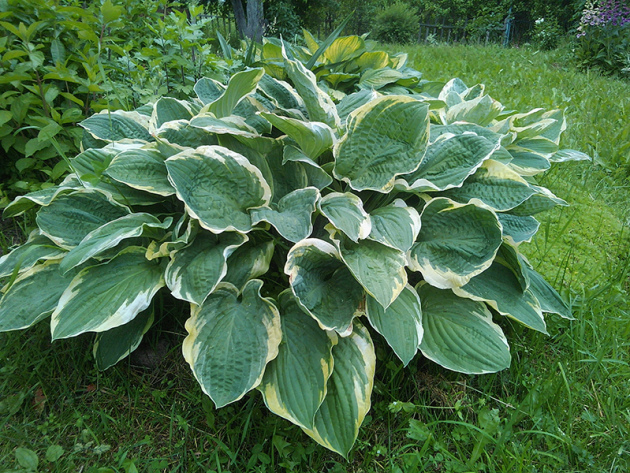


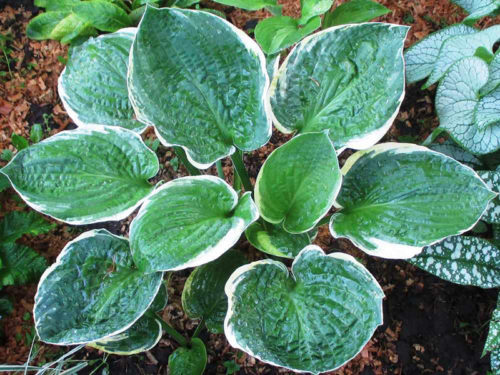
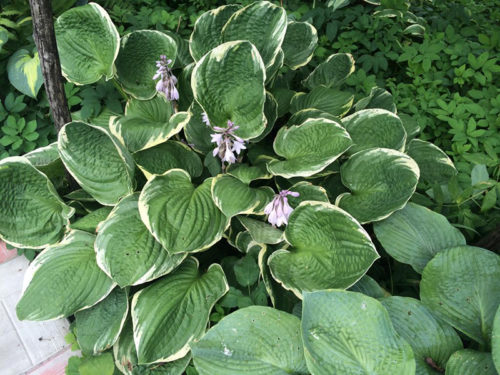

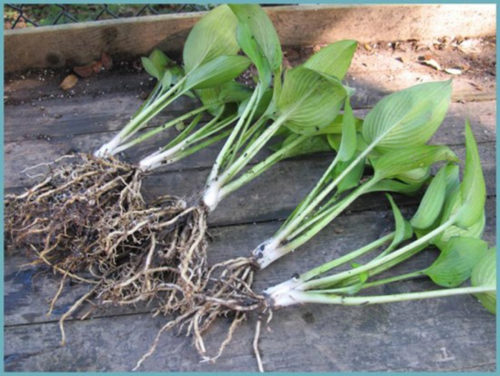
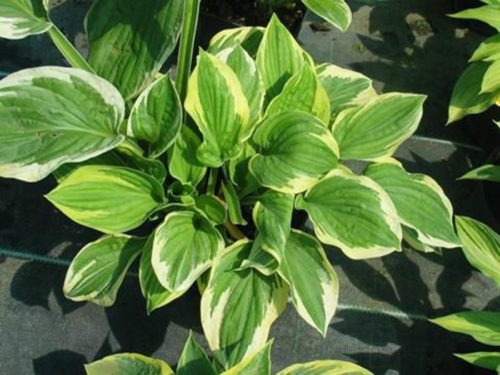
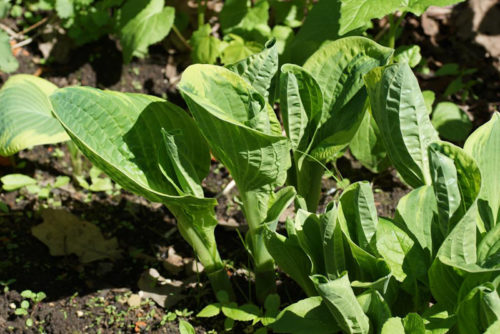


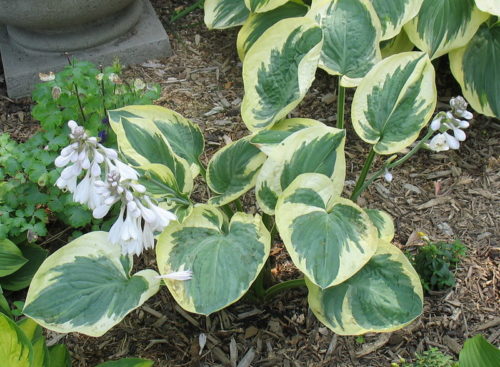
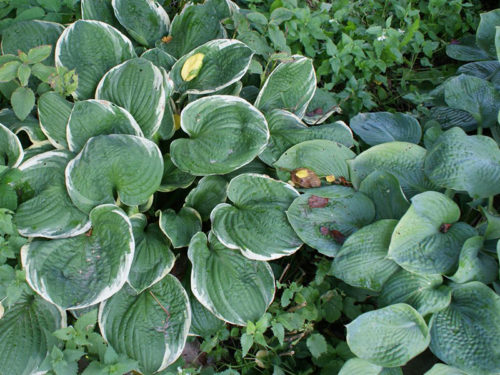
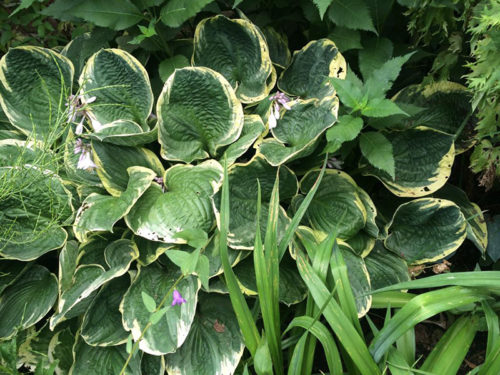












 Start a discussion ...
Start a discussion ...